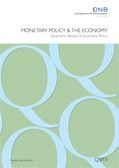Monetary Policy and the Economy Q3/18
Digital banking and finance OeNB
OeNB
- Erschienen:
- Oktober 2018
 OeNB
OeNB
Monetary Policy and the Economy Q3/18 (PDF, 1,9 MB) Oktober 2018
Call for applications: Visiting Research Program (PDF, 59 kB) en 23.10.2018, 00:00:00
Nontechnical summaries in English and German (PDF, 88 kB) en 23.10.2018, 00:00:00
Austria's economy set to grow by close to 3% in 2018 (PDF, 614 kB) Fenz, Fritzer, Rumler, Schneider. Economic growth in Austria peaked at the end of 2017. The first half of 2018 saw a gradual return to average growth. According to the most recent figures of the OeNB’s Economic Indicator of September 2018, this trend is set to continue in the second half of the year. Based on its quarterly forecasting exercise, the Oesterreichische Nationalbank (OeNB) expects real GDP in Austria to rise by 0.6% in the third quarter and by 0.5% in the fourth quarter of 2018 (quarter on quarter; adjusted for seasonal and working-day effects), and thus to remain above the long-term average growth rate of 0.4% until year-end. Thanks to particularly strong growth early in the year, the predicted growth rate for 2018 as a whole is 2.8%, slightly higher than in 2017. External economic uncertainties such as the further course of international trade conflicts and the Brexit negotiations represent a downside risk to the present forecast. Inflation is expected to remain on a steady course over the next few years. The OeNB forecasts a HICP inflation rate of 2.2% for both 2018 and 2019, followed by a slight decline to 2.0% in 2020. The fact that inflation is set to remain above 2% for the time being can be attributed mainly to favorable economic trends and robust growth in unit labor costs. HICP inflation is not expected to slow until 2020, when crude oil prices are likely to decline. Falling rates of inflation in the energy products market are expected to be largely balanced out by rising inflation rates in the services sector over the forecast horizon. As a result, core inflation (excluding energy and food) is projected to rise from 2.0% in 2018 to 2.3% in 2019 and level off at 2.2% in 2020. en 23.10.2018, 00:00:00
Digital money (PDF, 312 kB) Pichler, Schierlinger-Brandmayr, Summer. We provide a brief overview of the most popular forms of money available to the general public today, with a particular emphasis on digital money. We contrast current monetary arrangements with privately issued crypto coins, such as Bitcoin, and argue why the latter will likely never be able to perform the economic functions of money well. We relate our discussion to the current international debate on the potential introduction of central bank-issued digital currencies as a new form of digital money. en digital money, Bitcoin, blockchain, digitalization E5, E58, E50, E59 23.10.2018, 00:00:00
A primer on peer-to-peer lending: immediate financial intermediation in practice (PDF, 237 kB) Pointner, Raunig. Peer-to-peer (P2P) lending markets are young but fast-growing. Furthermore, P2P lending competes with traditional bank lending. Several questions arise: How big are fintech credit markets currently? How do the most common P2P lending models work? What are the risks and who bears them? How do platforms try to mitigate information asymmetries between lenders and borrowers? Who is using P2P platforms? Will P2P lending replace traditional bank lending in the future? This article addresses these issues and summarizes the empirical research on the topic, with a particular focus on developments in Austria. en fintech, peer-to-peer lending, crowd funding, bank lending G20, G23, G28 23.10.2018, 00:00:00
How Austrians bank and pay in an increasingly digitalized world – results from an OeNB survey (PDF, 1 MB) Ritzberger-Grünwald, Stix. The digital transformation in banking and payments has important consequences both for the financial industry and for consumers. Nevertheless, there has been limited empirical evidence about the diffusion of financial innovations among consumers in Austria. This paper presents the results of a nationally representative survey. The survey covers questions about how Austrians conduct banking, their use of innovative payment methods and services/products in the realm of financial technologies (fintech) as well as their ownership and awareness of crypto assets. Regression analyses are conducted to identify drivers of adoption of such services and products. The key variables across products are trust in the safety of a product, age, financial risk tolerance and interest in technology. Overall, the results reveal that the way Austrians bank and pay has been changing considerably. In particular, 58% of Austrians aged 14 or over use online banking and 36% use their mobile devices for banking activities. Contactless payments (without entering a PIN) are conducted by roughly one-half of Austrians. The use of several fintech services/products and ownership of crypto assets (2%) is confined to a much smaller share of Austrians. Despite the relatively widespread use of digital banking and payment products/ services, the results also show that a sizeable share of the population does not use innovative financial products, still visits bank branches and has a preference for using cash for daily purchases. Also, an overwhelming majority of Austrians (including those who use financial innovations) want cash to remain. en financial digitalization, banking, payment, fintech, innovations, cash, digital currency, Bitcoin, adoption E41, G20, O31, O52 23.10.2018, 00:00:00